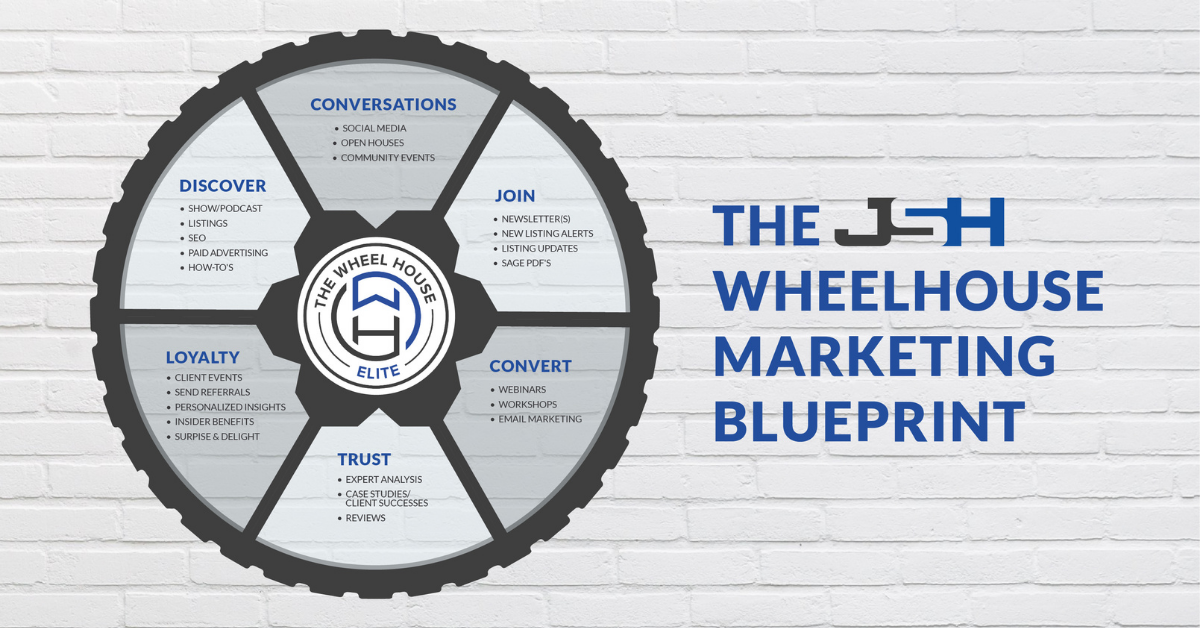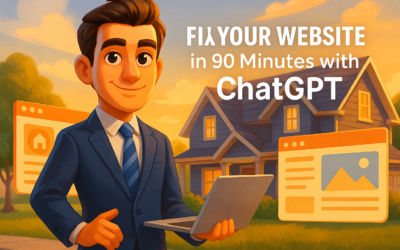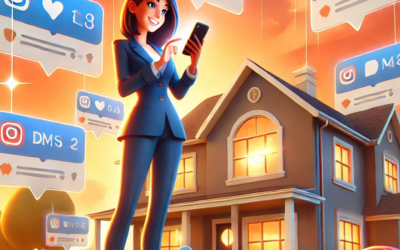Funnels are not a real estate marketing strategy.
They have a tactical place in different aspects of your real estate marketing but a successful business isn’t a single funnel. More and more marketers are talking about the switch from Funnels to Flywheels.
Instead of a funnel that pushes everyone down, the Wheel House approach to real estate has all the pieces feeding into the next, going around and around. If you approach it like a funnel you’ll have to keep pushing more and more money into the top of the funnel.
The Wheel House approach we use at Just Sell Homes has the different stages working together and feeding into one another to make it spin faster and faster. Instead of thinking about “Is this top of funnel content?” you can look at repurposing across all of your marketing.
This concept isn’t new. In 1957, Walt Disney showcased his version of a flywheel. Showing how all the different pieces of Disney can contribute to each other to build a massive business. This is not a concept specific to real estate marketing.
How does it work?
This post is going to break down the 6 spokes in your Wheel House Real Estate Marketing Strategy. You don’t need all of them on day one.. You can have a successful business only excelling at a couple. As you add them all together, your business will grow even more.
So let’s get into it.
Real Estate Marketing Spoke 1: Discover
The first stage of real estate marketing is to get people to discover that you exist. With so many choices of real estate agents out there, if they have never heard of you, they’re not hiring you.
You want content that gets you in front of people who don’t know you yet. For example, with our marketing here at Just Sell Homes, we have our show Over a Pint. In the beginning, we picked guests that agents would be interested in listening to. That way we’d get in front of those who knew of them but not necessarily of us, yet.
You can do that with local businesses. Pick popular places people would want to know more about, hear from the owner, etc… Leverage their name recognition to boost your own. Over time you’ll notice a switch where people are coming to you for the name recognition boost.
This doesn’t mean you HAVE to do a show to be successful at the Discover stage. It could be doing great blogging that gets you discovered on Google. SEO is one of the best ways to get discovered if you have the time to do it right.
Think about what people are searching for and provide the best answer for them. You can try and compete on terms like “Homes for Sale” but that’s going to be expensive and take a long time. At that level, you’re competing with people putting seven figure investments annually unless you get into paid advertising.
Paid advertising is definitely a shortcut to the Discover phase. Take a piece of content, put money behind it, and you can make sure you show up in front of people in the area you want. With a big enough budget, you can make yourself locally famous in only a few months from scratch.
What’s another easy way for people to discover you?
At the end of the day, people are looking for their next home or investment. Listings are the main currency. Leverage them and people will see you. Put Signs in the ground, create videos, post on social media, etc. Listings are a great way to get discovered.
If you have a steady stream of listings every month, it gives you a massive advantage over your competitors in your real estate marketing.
Once they discover you, you need to have conversations with them. Which leads to…
Spoke 2: Conversations
You got discovered, now the next step is to get conversations going.
The initial conversations don’t have to be real estate-focused. You just want people to have conversations with you to start. These can be on social, in person, or anywhere else. Don’t put less weight behind an online conversation, arguably a public conversation online can be just as or more valuable than an in-person because other people can see it and can lead to even more discovery.
On social, that means putting out posts that lead people to leave an actual comment. It means replying to stories. Sharing it with others. It means you are replying to other people’s content so that they’ll see you there.
Look for accounts that target your ideal clients and engage with them. [Do NOT do this on another real estate agent’s real estate marketing content, that’s poor form.]
Offline, open houses can be great for conversations as people start walking through and are more willing to engage in conversation with you. They’re already there, they’ll have questions. Startup a conversation. Don’t just sit at the kitchen table and ignore them.
Now, it’s important in this phase to leave the right impression. You want people to leave the conversation thinking “Now THAT is a true professional.”
As Phil Jones, author of Exactly What to Say says, you should go into every conversation with 3 things.
Curiosity: If the goal is to create certainty you have to show up with curiosity. Ask carefully crafted questions.
Empathy: Genuinely seeing it through the other person’s views. Empathy is to care about what people you care about care about.
Courage: The courage to ask bold questions.
Get them talking about themselves. Don’t talk about you, don’t sell yourself, just learn about their situation. Then once you have the full picture you can take the next step.
Have them join your “list”.
Spoke 3: Join
Early in my career, I heard the advice “always have something to invite them to.”
This is incredibly important for effective real estate marketing. Every time you have a conversation you should be prepared to give them something of value. For many real estate agents that means either regular emails with new properties or a home valuation.
Since every agent offers that, think about what else you can do that would be of higher value?
Our preferred method is a weekly (or more frequently if you’re willing) newsletter. Something filled with value. They won’t mind a weekly email if it’s of value to them. The reason most don’t send more often is their emails suck and deep down, they know it. If you’re sending monthly, newer people to your database might forget about you before the next one arrives.
At this stage, you want to consider what you *need* from them. If you’re willing to put the time in with good email marketing you don’t need their phone number yet. Without requiring a phone number you’ll get more people joining. If you don’t have a great email marketing system you’ll need their phone number to follow up to turn into new clients.
There’s a lot of ways that people do this from the simplistic forced registration to different lead magnets and a million other potential ways to collect their information.
Let’s break down a few of the simple ones you can do:
- Newsletter: It has to answer a clear ‘what’s in it for me”. That could be deal of the week, hot new listings, sold information, or something along those lines. These should go out weekly. An effective call to action is not “Join Our Newsletter.” For example, with our newsletter for Real Estate Agents our call to action is “Become the smartest Realtor in the room in 10 minutes once a week.”
- Listing Alerts: They say what type of home they’re looking for, you send them regular emails with new ones. Most MLS platforms will do this for you automatically each day.
- Listing Updates: This is one more people should do when they have a listing. Give people the ability to sign up for updates about specific listings. From new offers, open houses, conditional deals, and final firm deal followed by the sold price. Neighbours especially want to know what’s happening with a home for sale, giving them the ability to easily stay up to date.
- Forced Registration: A lot of consumers hate websites that do forced registration so keep that in mind BUT it’s an effective way to generate leads. There’s a lot of pros and cons to going this route so I highly recommend understanding the implications of putting forced registration on your website before doing it.
- Lead Magnets: These are extra resources they can download in exchange for providing their contact information. We follow the SAGE principle when creating lead Magnets. That means they should be Short, Actionable, Goal Oriented, and Easy to Consume. 2-3 page PDFs that focus on a specific outcome are our preferred method.
The short version is just having something valuable enough for them to want to give their contact information. Don’t overthink it. You just need something that has enough value to them you can invite them to join that makes it worth giving their contact information for.
You get them to join your list, then comes the fun part, getting them to convert into clients.
Spoke 4: Convert
This stage is where most struggle with their real estate marketing, converting people who have reached out at some point into actual clients. To oversimplify this process, you need a two-part system.
Part 1: Identify the “ready-now” people and convert them
Part 2: Everybody Else
Only a small percentage of people you have on your list are going to be ready to move soon.
This is the group that most agents focus on with their lead conversion strategies. It’s also the smallest group of people in your leads.
How many calls to make, texts to send, emails to send, and talking about speed to lead. All of that matters but it can be too heavily relied on by many. They follow up, follow up, follow up, and then if someone isn’t ready to go in the next 30-90 days they let them go. Some coaches will even say to throw away leads that aren’t ready in the next 90 days.
We’ll create another post about the initial sequences for reaching out to leads but it’s also the most covered part of content outside of lead generation. There’s a lot of great information out there about it.
People who reach out, on average, can be 12-18 months away from moving. You need a system in place for long-term follow-up.
In your newsletter you’re going to start sending every week, add some content to it that encourages conversions. Get people to put up their hands to talk about real estate. That could be about specific properties, education, or advice.
Webinars and in-person workshops are great for this. It gives people a no-pressure environment to get more information and convert into clients.
Strategically sending emails out to your list with opportunities is great for conversion. If you have a buyer looking in an area a simple “Hi , we have a buyer looking for a home in your neighbourhood but nothing on the market is right for them, have you heard of any neighbours thinking about moving? SIGNATURE”
Short, sweet, and easy to start a conversation with. You can flip that and say you have an upcoming listing and would they like to help choose their next neighbour?
The goal with the convert stage is to get them to take the next step, an in-person meeting where you’ll be able to get a signature on the dotted line.
Spoke 5: Trust
Signed or not, people need to trust you. This means you want to keep marketing to them at every stage of the relationship.
When someone is a client, you should start doubling down on it. You need to give them complete confidence they made the right decision.
Similar to how some experts say you should never stop dating your spouse after you get married. You never stop marketing to them. Your goal here is to build trust. The best part of the Trust content is it can be used, repurposed, and distributed at almost every single stage. It’s incredibly important to have for every spoke.
The most important part of the Trust spoke is showing them how to do things the right way. Helping them avoid common pitfalls, solving problems, and communicating with them. They need to have confidence in you. Could be how to buy their first investment property or as simple as “How to Get Pre-qualified for a Mortgage.” It needs to address their specific situation and should give them the feeling of “(s)he gets me.”
Our recommendation, whether it’s video, written, audio, etc… is to create content that answers the 10 most common questions you hear from clients. When I sold real estate, “What is a Bully Offer?” drove a ton of traffic to my website.
After you have that, answer the 10 most common questions people SHOULD ask but don’t know to ask. For example, if someone is buying a cottage in Muskoka, they need to know about road shore allowances but most would do not know to ask about that.
Your expert analysis is what will set you apart and build trust. Anyone can regurgitate the stats your board puts out every month. You can help them understand what those stats mean to them. In an ideal world, they’d consume your content and think “Ohhhh I didn’t know that’s how it worked!”
Another great example of this, are just sold ads. Most agents will post something along the lines of “I sold this in 3 days for way over asking!”
Does that build trust or does it make you look like you’re just bragging about how much money you just made in no time at all?
Instead, focus on the consumer and educate them. “How John & Sarah sold their home in 3 days for $20,000 more than they thought possible”
Now it’s about them. You want prospective clients to see it and be like “I want to be like John & Sarah, I was where they were back then, I want to be where they are now!”
Do you know how they can get to where they are now? Hiring you.
The other big trust-building activity is to lean heavily into getting reviews from your clients. Our recommendation is to push towards Google Reviews or a tool like RankMyAgent, then repurpose those for your marketing.
Whether you’re doing case studies, how-to content, gathering reviews, or any other trust-building content, try to include as many specifics as possible. Instead of saying “We sell homes faster” try “We sell homes 12.3% faster than the average REALTOR”
People tend to believe statistics and assume vague claims of being better are likely to be fake or over-exaggerated.
Trust is important, earning it matters, and you can use these pieces of content throughout your marketing.
Spoke 6: Loyalty
Just because someone has hired you once, doesn’t mean they are guaranteed to hire you again. You have to work on earning their loyalty and staying top of mind. You want them to think about you like their favourite sports team. There’s no question of who they support and they’ll be coming back to you time and time again. They’ll defend you in group chats and promote you as much as possible.
Hosting events for your past clients is always recommended. Most top producers who focus on their database host regular client events. These can range from renting out a movie theatre to hosting a BBQ at their home, or even hiring a photographer and a Santa at the holidays and doing family photos.
The key to a great event is to make it appeal to as many of your clients as possible. If you work with a lot of families, make it family-friendly. If you’re mostly dealing with young childless couples you may be better doing events at local breweries for example. If a lot of your clients have pets, do a pet photography session.
Pro Tip: Everyone who RSVPs yes, send them a follow-up saying “It’s always more fun to have fun with a friend, if you’d like to invite a friend just let us know and we’ll make room for them, too!”
You also want to become their resource for local help. If they need a contractor, you should have a local list ready to supply people of those you trust. You can even take this a step further and go negotiate discounts or benefits to your clients with your preferred vendors. Make it so that anything home-related they want to do, they know they can come to you for help.
One agent we’ve spoken to even goes as far as to have a full time handyman on staff and past clients are allowed to have a full day with him each year to do whatever projects around the house they want. That’s a great way to build loyalty, your clients will never go anywhere and it’s such an easy way to stay top of mind by having someone on your team be in the house every year.
On top of that, on the anniversary of their purchase every year, send them an updated personalized home value. Let them know where they stand in terms of what their home is worth now. If it’s gone up quite a bit, it’s the perfect time to also ask them if they’ve ever considered getting into investing by leveraging the equity in their home. Now the wheel can start over again as they’re discovering the potential for investment properties, have a conversation with you about it, join your investment opportunities list, and then convert into clients who buy investments.
There’s studies that show “Surprise & Delights” can be one of the most effective ways to build client loyalty. Instead of Christmas gifts, you can do gifts at other times of the year. Everyone is expecting something at Christmas but a random gift in September? No one sees that coming and they’re more likely to talk about it. The best gifts cause them to have conversations about it.
With gifts, it’s great to leave your name and logo off of them. Give them something with THEIR name on it, something they’d want to display in their home.
When people ask where they got it, they get to talk about you now. If your logo is on it they’re less likely to display it and no need for that conversation since the person already knows where they got it. You want to create conversations with everything you do. Having someone ask them about that great unique gift means you’re giving them the opportunity to talk about you glowingly.
This allows more people to discover you, starting the whole process over with new people.
Real Estate Marketing Redefined
Building a solid real estate business is hard. It takes a lot of work. You can have a great business without having all 6 spokes in place but you need at least a couple. As you get them perfected, start adding the next one, and keep going until you have them all running.
Once you have your real estate marketing systems in place, it will feed itself and grow bigger and bigger. The different spokes can all feed into one another. No single spoke should be looked at as an island unto itself. You can refine it as things change but having all of this in place means when new platforms and shiny tools you can evaluate it to see if it fits and where it might work for your business. If it doesn’t fit, you don’t need to pursue it.
Traditional funnels focus too much on “This stage leads to this stage leads to this stage.” When you focus on funnel vs the wheel you get trapped into the traditional chasing business model instead of attracting business.
Stop chasing, start attracting.
Implement the Just Sell Homes Wheel House Marketing Blueprint and grow your business.
Want our help with your real estate marketing? Book a call with our team to see how we can help you implement.






0 Comments